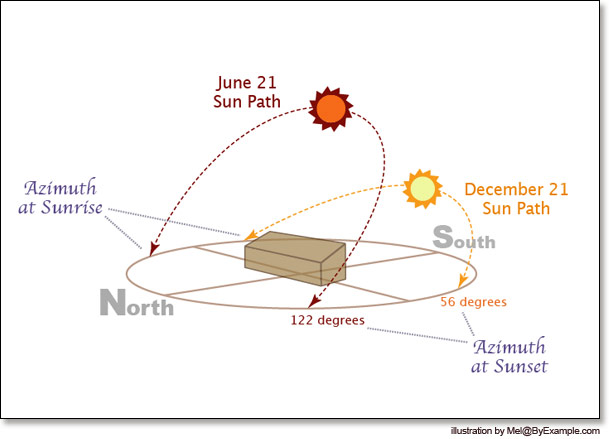The most important and fundamental energy-saving strategy you need to know about in Phoenix is shading your home from direct sun and heat gain. Well-positioned shade around your house can save you up to 40% in your cooling bills.
We explored creating shade from a planting perspective on the Blooming Rock blog on the week of March 15, 2010. This week, I’m revisiting the topic of shade because it’s so very important for our climate especially with the upcoming hot weather. I’ll be talking about shade from an architectural perspective and today we’ll start with a primer on home orientation and which sides of your house need different types of shade.
There are three sides of your house that you need to shade: the south, west and east sides. Below is a diagram that shows how the sun moves during the day. It shows the summer and winter path of the sun. You can see that your house will never get direct sun from the north side, so you don’t have to worry about shading that side. In fact, the north side usually provides lovely indirect, glare-free daylight so you want to keep the windows on that side of your house as free from obstructions as possible.
diagram from By Example The Quest for Sustainable Living
On the east and west sides of your home, the sun is coming in at a much lower angle then it does when it’s on the south side of your home. Since the sun rises from the east and sets in the west, you need vertical shade on these sides of your home to protect from the low morning and afternoon sun. Remember that the afternoon sun is the hottest so shading your west-facing windows should be your top priority. Trees and high shrubs in front of east and west windows do a good job of shading plus provide a beautiful view. See Doreen Pollack’s guest blog posts for more information on this strategy.
Around the noon hour, the sun will be coming from overhead on the south side and you can shade your home with a horizontal device such as an overhead trellis or an awning. If you have a covered back patio on the south side of your house, it’s a perfect way to shade that side of your house. In the winter, when the sun is lower, your south-facing horizontal shade should let some of the sun through to then heat your home when you need it.
Paying attention to the orientation of your home and where your windows are can pay big dividends when it comes to saving money on your energy bill. Many people think it doesn’t matter what you do on the outside as long as you close your curtains or blinds on hot days. Heavy window treatments could be used as a supplement to exterior shade but definitely do not replace it. Personally, I’m not a big fan of closed curtains or blinds as they cut out daylight and views of nature.
What you need to know is this: stopping the heat from getting into your home with exterior shading devices is much more effective than mitigating it once the heat has entered your home. That’s why exterior shade is such an important aspect of saving energy in Phoenix. Using passive cooling strategies such as exterior shade along with your air-conditioner to keep you comfortable in the summer is a great way to take some of the burden off of your mechanical systems. It’s also one of the most effective ways to reduce your carbon footprint AND save money!



















[…] yesterday’s post, I explained the basics of building orientation and the appropriate types of shade for the east, […]
[…] basics on passive solar design, look at my earlier post. And next time you’re out and about in Phoenix, check if buildings are shaded correctly, if […]